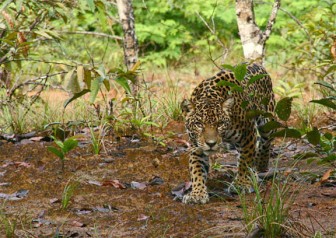The Jaguar (Panthera onca) is the largest cat in the Americas and ranges from the south western US to Argentina. There is much colour variation in jaguars, but in general, they are a tawny golden colour on the back and sides with a white underbelly, and are spotted with black rosettes all over.

The ‘black jaguar’ is one such specific colour variation and its rosettes are visible at certain angles; black jaguars occur rarely in all populations. Jaguars vary in size, with adults generally weighing between 45-90 kg and measuring approximately 2.5 metres from nose to tail. They are top predators in the forest and savannahs and are excellent swimmers. They are stocky and strong, and stalk their prey rather than chase it. They will hunt at any time of the day or night, using their powerful jaws and teeth to pierce the skull of their prey, a technique unique to jaguars and very useful for cracking the shells of turtles, one of their favourite prey. Other prey include capybara, deer, monkeys, and fish. In areas where humans live, jaguars will also prey on domestic animals such as dogs and cattle.
Jaguars are secretive, but like many wild cats, they take advantage of man-made trails and roads in the forest, so, sometimes, lucky travellers can see jaguars on the trail when driving though the Iwokrama Rain Forest. Jaguars are threatened with extinction as their natural habitat is converted and developed for human use, and it is illegal to trade them or their parts for commercial purposes. The jaguar is Guyana’s national animal and two can be found proudly sitting within Guyana’s coat of arms.
Rain forests are rich in biodiversity and are home to many different plants and animals. In addition, indigenous communities live there. Even if you don’t live in the rain forest, humans rely on the forest for resources such as building materials (wood and lianas), medicine and fruits. Rain forests also provide essential environmental services for life on earth;  they create soil as well as prevent soil erosion, produce oxygen though photosynthesis, maintain clean water systems, and are a key defence against climate change.
they create soil as well as prevent soil erosion, produce oxygen though photosynthesis, maintain clean water systems, and are a key defence against climate change.
The Iwokrama Rain Forest is 371,000 hectares, located in the heart of Guyana. Our mission is to develop strategies for conservation and sustainable development for local people in Guyana and the world at large. We are involved in tourism, training, research and our timber is certified by the Forest Stewardship Council. Come and visit us in the rain forest or at http://www.iwokrama.org.





